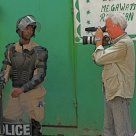WATCH 16X9: The skeleton of King Richard III was recovered under a parking lot in the city of Leicester.

A royal battle is brewing over what to do with the 500-year-old bones of England’s King Richard III—a fight pitting scientists against an historical group that believes his remains should be allowed to “rest in peace.”
The Looking for Richard (LFR) project charges that scientists at the University of Leicester, England, are performing “destructive tests” on Richard’s skeleton—work that wasn’t approved by the people who paid for the excavation of the bones, or by living descendants of the controversial king.
The story of that excavation, and the identification of the bones using the DNA of a Canadian furniture-maker, was told in this 16×9 report last season by Sean Mallen.
The LFR people say that since they commissioned and paid for the excavation of the bones–identified last year as King Richard’s–they should have a say in how the remains are treated.
READ MORE: A Battle Over Old Bones
“We were promised that once identified, Richard III would be treated with the utmost respect,” they say. “Accordingly, we are calling for destructive sampling to be halted immediately.”
Leicester University says it is taking only small fragments of the skeleton, and that the lab work is being carried out under strict codes and procedures.
- Posters promoting ‘Steal From Loblaws Day’ are circulating. How did we get here?
- Video shows Ontario police sharing Trudeau’s location with protester, investigation launched
- Canadian food banks are on the brink: ‘This is not a sustainable situation’
- Solar eclipse eye damage: More than 160 cases reported in Ontario, Quebec
“King Richard III is a figure of immense historical and cultural significance,” the university says in a statement, “and the information that we hope to obtain from sequencing his genome will provide insights into the health and ancestry of the king and his historical environment.”
But that doesn’t sit well with the LFR’s John Ashdown-Hill, the author and historian who established the genetic link between King Richard and Canadian Michael Ibsen. He says the whole purpose of the excavation was to recover the monarch’s remains from an “ignominious” grave—under a parking lot on university grounds– and to give him a proper burial.
READ MORE: 16X9: Old Bones
Richard III, portrayed by Shakespeare as an villainous and scheming hunchbacked monarch, was killed in 1485 at the Battle of Bosworth Field, ending the War of the Roses and bringing the curtain down on the Middle Ages in England. His remains were only discovered in an unmarked grave in Leicester in August 2012.
That identification was made by comparing the DNA of one of Richard’s surviving teeth, with the DNA of Michael Ibsen, a 17th-generation descendant.
Ashdown-Hill says that tampering with royal remains—even for scientific reasons—is unethical, and violates a precedent set by the UK House of Lords in 1965, when it forbade scientific work on the bones of a royal princess.




Comments